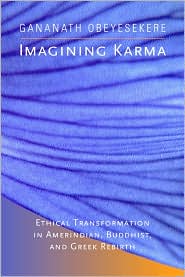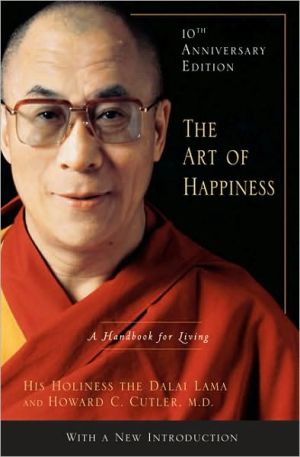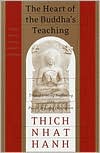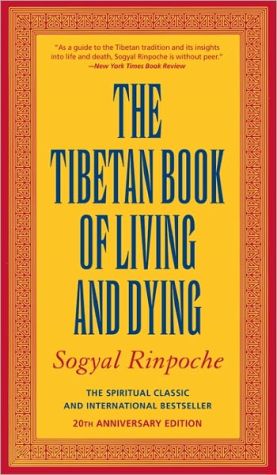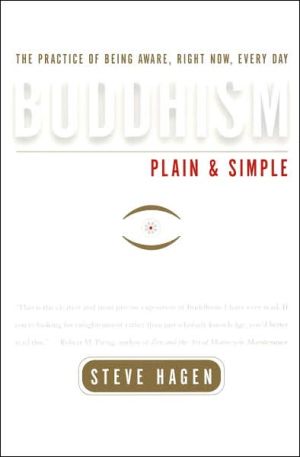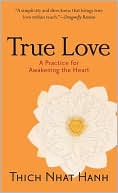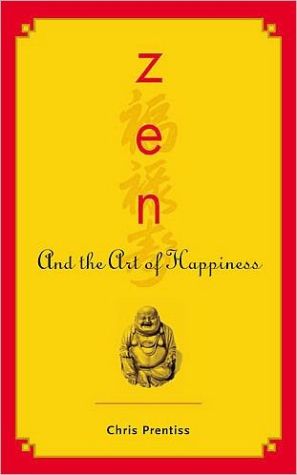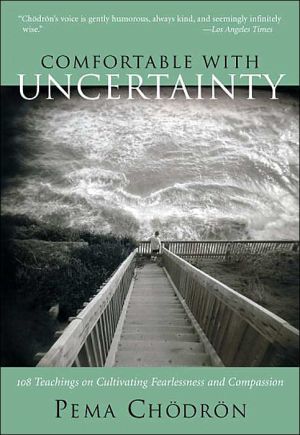Imagining Karma: Ethical Transformation in Amerindian, Buddhist, and Greek Rebirth
With Imagining Karma, Gananath Obeyesekere embarks on the very first comparison of rebirth concepts across a wide range of cultures. Exploring in rich detail the beliefs of small-scale societies of West Africa, Melanesia, traditional Siberia, Canada, and the northwest coast of North America, Obeyesekere compares their ideas with those of the ancient and modern\ Indic civilizations and with the Greek rebirth theories of Pythagoras, Empedocles, Pindar, and Plato. His groundbreaking and...
Search in google:
"This work is a tour-de-force in cross-cultural scholarship, both sound and bold, constructing a new and refreshing theory on the rise to prominence of rebirth eschatology in India. Obeyesekere argues convincingly that 'ethicization' of rebirth through the theory of karma was the new ingredient that transformed a commonplace belief into a central philosophical and eschatological principle in most of Indian theologies. This is a book that will engage and challenge anthropologists, classicists, and Indologists alike, as well as non-specialists interested in culture and religion."—Patrick Olivelle, University of Texas at Austin"This is a book in the grand tradition of comparative studies, pulling together anthropology, psychology, psychoanalysis, classics, Indology, and history of religions, but in a distinctly contemporary mode. Few scholars would attempt such a project today, let alone pull it off so intriguingly as Obeyesekere does. A brilliant and intellectually courageous book."—Paul B. Courtright, Emory University, author of Ganesha, Lord of Obstacles, Lord of Beginnings Patrick Olivelle This work is a tour-de-force in cross-cultural scholarship, both sound and bold, constructing a new and refreshing theory on the rise to prominence of rebirth eschatology in India. Obeyesekere argues convincingly that 'ethicization' of rebirth through the theory of karma was the new ingredient that transformed a commonplace belief into a central philosophical and eschatological principle in most of Indian theologies. This is a book that will engage and challenge anthropologists, classicists, and Indologists alike, as well as non-specialists interested in culture and religion.
Imagining Karma\ Ethical Transformation in Amerindian, Buddhist, and Greek Rebirth \ \ By Gananath Obeyesekere \ University of California\ Copyright © 2002 Regents of the University of California\ All right reserved.\ ISBN: 0-520-23243-7 \ \ \ Preface\ In this book I examine three eschatologies that until now have not been put together in any kind of systematic comparative perspective: the rebirth doctrines of small-scale societies in various parts of the world, such as West Africa, Melanesia, the Northwest Coast Amerindians, and the Inuit (Eskimo); those in the Buddhist, Jaina, and other religions that flowered in the Ganges valley around the sixth century b.c.e.; and those of the Greeks of the Pythagorean tradition of roughly the same period, which culminated in the soteriological and cosmological thought of Plato and of Plotinus in later times. I maintain that this material can be read at several levels. The comparative perspective can apply to each of three broad substantive domains that I deal with here. The rebirth theories of small-scale societies discussed in chapter have structural similarities that derive to a considerable extent from their smallness. Take two ideas common to virtually all of these societies: first, a dead person will circle back to the same kin group; and second, a neonate can be identified as a specific ancestor returned. I show that although the first feature is applicable to every small-scale society in my sample, the second feature is absent among one of them, the Trobrianders. I demonstrate in my analysis that among Trobrianders it is meaningless to so identify the neonate, given this society's notion of ancestors as mostly anonymous beings. It would be logically and structurally impossible for Trobrianders to get interested in the issue of the identity of the neonate. I also show that among the small-scale societies mentioned in this work there is a fundamental difference between the Amerindians and the rest, that is, West Africans and Melanesians: the presence of animal rebirth in the former and its absence in the latter. The presence of animal rebirths in Amerindian-Inuit societies permits us to establish an important link, methodologically speaking, with both the Buddhist and Greek worlds, which share that same propensity; and it helps us isolate Amerindian and Inuit forms of rebirth in our sample of preliterate societies as the ones most significant for comparative purposes. \ As in the small-scale societies mentioned above, Buddhist and Greek doctrines of rebirth also permit internal comparisons such that the Indic religions exhibit close similarities and differences, as do the Greek ones. However, the main point of this work is not to demonstrate internal similarity and difference but to examine structural similarities and variations across the great cultural divides that separate Amerindian, Buddhist, and Greek rebirth doctrines. This may seem a hopeless task at first glance because anyone knows that on the substantive level the actual ethnographic or historical accounts of rebirth theories are vastly different, and there is little to connect Buddhist, Greek, and Amerindian rebirth. Yet this work will show that underlying these vast differences are important structural similarities and variations based on a shared belief in reincarnation, which I show has an unvarying "elementary structure." Hence the methodological thrust of this book: I can demonstrate how transformations can occur on the basis of this common elementary structure, which permits me to depict and compare limited "topographical models" of rebirth theories across great cultural divides. But the structural models are not anchored to universalist theorizing as in Lévi-Strauss's structuralism; rather they have been constructed in the manner of "ideal types" geared to my specific research interest. Thus, this book is an attempt to demonstrate that, although one must eschew universalistic lawlike theories modeled on the natural sciences, one must also reject the contemporary fascination in my own discipline for ethnographic particularity and a rejection of theory unless it shows that no theories are possible outside descriptive specificity. In this work I make the claim, and demonstrate as best I can, that limited comparison and theorizing are possible in the human sciences.\ The topographical models I have constructed simplify the complexity of eschatologies on the ground, as it were, permitting us to focus primarily on specific issues of structural similarity and transformation rather than on substantive content. Still, any idea of structure is senseless without the substantive content that permits the construction of simplified models. Once the models are constructed, one can infer some "expectable" features of content in the empirical record. For example, I show that from a structural point of view one could expect societies with rebirth doctrines to show a preoccupation with "endoanthropophagy" (endocannibalism). In reality some do, and some don't; but once one isolates the structural problem of endoanthropophagy, it is possible to adduce reasons for the absence of this phenomenon in specific cases, such as in Buddhism, or, failing that, to at least describe the absence in a specific cultural context. In other instances even these operations may not be possible because of the paucity of relevant sociological and historical data.\ The preceding remarks may suggest that I have ventured into abstract realms of little concern to Indologists and classical scholars. Although I primarily address anthropologists, historians of religion, and other inquisitive intellectuals, I try to present my argument in a fashion intelligible to those outside the human sciences. Moreover, readers who are put off by abstractions and who are unsympathetic to my theory of ethical and structural transformation might find provocative my descriptions and incomplete interpretations of specific rebirth eschatologies and cosmologies from different regions of the world.\ The comparative information might also surprise many scholars and lay readers who have been prejudiced into thinking that such doctrines are the exclusive preserve of the religions of India. My initial rationale for embarking on this project was to justify decentering India as the home and ground of rebirth. But I go beyond my Buddhist prejudice to a vision of a larger purpose: I explore the common fate of those societies that through historical accident or through the circulation of ideas or through independent invention have come to believe in reincarnation as an integral part of their larger eschatological and cosmological belief systems. In the more abstract arguments presented in this work I explore the implications of that common fate. Another, related, major theme pertains to general epistemology, namely, how thought is constrained within the frame of preexisting knowledge structures-what Foucault called "epistemes"-and the freedom and leeway for innovation and debate permitted to the individual virtuoso or layperson.\ This book had a very modest beginning. The problem of the ethical transformation of a previously "amoral" eschatology into a more complex karmic doctrine was one of my early intellectual concerns, but at that time I framed my concern in terms of the origin of the karma theory. I first presented these ideas in Edmund Leach's seminar at King's College, Cambridge, in 1964 and subsequently published them in "Theodicy, Sin, and Salvation in a Sociology of Buddhism." In this first paper I had little information on rebirth theories outside of the Indic area, but I soon discovered the Trobriand eschatology. In 1971, at the 28th International Congress of Orientalists in Canberra, I presented a paper with the deliberately facetious title "Why Is There No Buddhism in the Trobriand Islands?" (which even I did not have the temerity to publish!). In 1980 I followed this paper with "The Rebirth Eschatology and Its Transformations: A Contribution to the Sociology of Early Buddhism," an essay that brought in data from Igbo, Trobriand, and Pythagorean and Orphic religions. However, fascinating and crucial data from the Northwest Coast Indians and the Inuit were absent. Until I read papers by Antonia Mills, I was ignorant, like many others, that Amerindians possessed theories of reincarnation. I participated in a seminar organized by Mills and wrote a foreword for her collection of seminar papers, subsequently published under the title Amerindian Rebirth: Reincarnation Belief among North American Indians and Inuit. In that foreword I relate Amerindian rebirth theories to those theories found on the Indian subcontinent. Amerindian rebirth provoked me to rethink the problem of karma, not so much in terms of its origins but in relation to structural and ethical transformations. Nevertheless my early bias toward Buddhism is reflected in the present work. Some of my most important theoretical findings-including the central concept of "ethicization"-are a product of my engagement with early Buddhism. Yet my engagement with rebirth eschatologies of small-scale societies has in turn affected my understanding of both Buddhist and Greek rebirth doctrines.\ I was able to rethink these early interests during my sabbatical in Sri Lanka as a Fulbright scholar during the 1993-94 academic year. As always, Sri Lanka, in spite of the violence in which it was enmeshed, inspired my creativity, and during the course of that year I wrote a preliminary draft of this book, focusing on the Amerindian and Indian material but excluding the Greek. The reason was simple: I found my foray into the Greek world in my 1980 paper shallow and unsatisfactory. I therefore decided, somewhat reluctantly, to ignore it. My sabbatical culminated in a marvelous stay at the Rockefeller Center in Bellagio, where I had hoped to put the finishing touches to the book. During my leisure hours at Bellagio I began to reread Plato and whatever was available on the Presocratics at the Bellagio library. I soon recognized that I had no choice but to use the Greek material because, like the Indic and the Amerindian, it included the notion of animal rebirths, a notion crucial to my comparative perspective.\ Thus the Greeks came to stay in my book. The Presocratic Greek material was especially difficult for me owing to its fragmentary nature, and this difficulty was compounded by the fact that classical scholars sometimes address their own circles with little serious comparative or theoretical thinking. The task was rendered even more difficult because two writers, H.S. Long and M. Peris, who dealt with this topic explicitly, did not always render the Greek into English. Fortunately, I soon invented my own rationale for bringing in the Greek material, and it can be briefly stated as follows: Contemporary scholars and intellectuals in the West quite rightly see the Greeks as the fountainhead of Western culture, and this view has resulted in a special take toward ancient Greece, one, for example, that highlights Greek rationality and its "enlightened" thought. In this scheme Plato is a key figure, the epitome of the Western speculative philosopher, whose thinking has come down through the Neoplatonists into later Christian theology. Yet Europe as we now understand it scarcely existed in Plato's time or in the time of the Pythagoreans that are the foci of my study. Although European thinkers see the Greeks as their intellectual forebears, the Greeks themselves looked toward the East for the sources of true wisdom-to Egypt, Persia, and, during the early centuries of the common era, India. Thus tradition has it that early Greek thinkers traveled East in their quest for knowledge. Pythagoras, for example, is said to have wandered into Egypt and later to have sat at the feet of Zoroaster. These traditions might not be based on fact, but they do illustrate the reality that Greeks saw the East as the source of knowledge, in much the same way that modern Europeans relate to the ancient Greeks.\ This should not surprise those of us who believe that the ancient world, not just Eurasia, was an open one. Along trade and caravan routes and in military campaigns ideas traveled vast distances, borne by merchants, soldiers, early voyagers in flimsy ships, and itinerant religious specialists and wanderers. Recent studies by scholars such as M.L. West, W. Burkert, and P. Kingsley have shown that the idea of Greeks looking to the East is not pure fantasy and that they were influenced by a multitude of ideas stemming from those regions. Kingsley's work, which I read only after this book was nearly completed, is especially interesting because he shows that Pythagoreanism, and this includes Plato's cosmology, was directly influenced by West Asian and Near Eastern thought and ritual structures and that forms of Pythagoreanism filtered into later hermeticism and alchemy in Europe. Nevertheless, I think that Kingsley's own work, contrary to his avowed intention, generates a more or less uniform stream of Pythagoreanism instead of multiple life-forms exhibiting epistemic breaks and differences beneath family resemblances.\ Looking at Greek thinkers from my particular approach meant taking their rebirth eschatologies seriously. Although classical scholars do recognize the importance of rebirth doctrines among the Presocratics such as Pythagoras and Empedocles, they rarely do for Plato. But to me Plato's thinking must be seen not in terms of a then-nonexistent European tradition but of existing thinkers in the then-known philosophic world, not just in the Greek world but the known contemporary world of which Greece was a part. In this work I am not primarily interested in the classicists' version of Plato as a philosopher or as a political and ethical thinker. I am concerned rather with Plato as a rebirth theorist and soteriologist who had a spiritual affinity with those of the Indian subcontinent, especially the Buddha. Those who have read the dialogues of the Buddha must surely be aware of their stylistic resemblance to Plato's dialogues, even though the Buddha was not interested in secular polity as Plato was. One does not have to posit actual contact between early Greece and India, although this was both possible and likely. Methodologically, however, given the mode of analysis employed in this book, one has only to recognize that Plato and the Buddha made sense in respect to their times and, given the power of their thought, affected human thought in general. Adopting this perspective I began to see Plato's rebirth eschatology as central to his cosmology and soteriology, not external or peripheral to it. The overwhelming majority of classical scholars, however, tend to treat Plato's rebirth theories as an allegorizing tendency or to simply ignore them. Yet it is interesting to note that Plato's disciple Plotinus treated his master's rebirth theories as literally true and imputes to Plato that same belief.\ \ (Continues...)\ \ \ \ Excerpted from Imagining Karma by Gananath Obeyesekere Copyright © 2002 by Regents of the University of California. Excerpted by permission.\ All rights reserved. No part of this excerpt may be reproduced or reprinted without permission in writing from the publisher.\ Excerpts are provided by Dial-A-Book Inc. solely for the personal use of visitors to this web site. \ \
List of IllustrationsPrefaceList of Abbreviations1Karma and Rebirth in Indic Religions: Origins and Transformations12Non-Indic Theories of Rebirth19West Africa19The Trobriand Model28Animal and Human Reincarnation: Northwest Coast Indians and Inuit (Eskimo)37Human and Animal Transformations43Kinship, Rebirth, and Desire46Tlingit Eschatology: Rebirth, Desire, and the Return of the Dead50Animal and Human Reincarnation: An Ethical Dilemma among the Kwakiutl583The Imaginary Experiment and the Buddhist Implications72The Transformation of the Rebirth Eschatology72Emergence of the Karmic Eschatology78Upanishadic Ethicization: The Earliest Indic Model84The Model and the Buddhist Interconnections88Ethicization in Its Historical Context: The Samanic Religions97Contemporary Tribal Religions98Ethicization, Axiology, and the Brahmanic Tradition99Nonethicized Samanic Religions: The Doctrines of the Ajivikas102Eel-Wrigglers and Hair-Splitters: Contentious Discourses in Buddhist Thought108Ethical Transformation and the Axial Age: Ethical Prophecy and Ethical Asceticism115Rationalization and the Transformation of Thought120The Limits of Innovative Thought: Temporality, Impermanence, Nirvana125Karma, Causality, and the Aporias of Existence129Ethicization, Karma, and Everyday Life140Ascetic Religiosity and the Escape from the World1444The Buddhist Ascesis150The Imagined Buddha150The Renunciatory Ideal in the Buddhist Imagination158The Buddha as Seer: The Life Fate of the Buddhist Dead160Samanism and Shamanism: Ecstasis, Enstasis, and Spirit Possession164Ethicization and the Creation of a God-Making Machine168Ethicization and Axiologization173Buddhism, Axiologization, and the Vedic Tradition176Axiologization Continued: Homo Hierarchicus and Homo Aequalis in India1825Eschatology and Soteriology in Greek Rebirth190Methodological Remarks190Pythagoras and Pythagoreanism: A Probable Mythos193History Telling Continued: Pythagorean Beginnings and Lifeways200Pythagorean Soteriology207Ethicization and Soteriology in Empedocles214Ethicization Step 1: Popular Religiosity in Pindar232Orphic Reincarnation: A Brief Aside236Bridging Multiple Worlds: Plato and the Myth of Er2406Rebirth and Reason249Metacosmesis in the Phaedo249The Soteriology and Eschatology of the Phaedrus254The Cosmology of the Timaeus258Cosmological Homoeroticism, Heterophobia, and Female Nature in Platonic Rebirth266Ethicization and Soteriology in the Platonic Dialogues270Regrouping: Rebirth, Memory, and Retrocognition275Reason, Conviction, and Eschatology in Platonic, Buddhist, and Amerindian Thought283"Karma" in Greek Thought: Plotinian Eschatology and Soteriology287Rebirth and the Idea of God: The Druze Case3087Imprisoning Frames and Open Debates: Trobriander, Buddhist, and Balinese Rebirth Revisited319Reincarnation, Procreation, and the Embodiment of the Soul319Buddhism, Procreation, and Rebirth331Balinese Rebirth: Contentious Discourses on Rebirth and Karmic Eschatologies334Methodological Postscript344Notes361Bibliography413Index429
\ Patrick OlivelleThis work is a tour-de-force in cross-cultural scholarship, both sound and bold, constructing a new and refreshing theory on the rise to prominence of rebirth eschatology in India. Obeyesekere argues convincingly that 'ethicization' of rebirth through the theory of karma was the new ingredient that transformed a commonplace belief into a central philosophical and eschatological principle in most of Indian theologies. This is a book that will engage and challenge anthropologists, classicists, and Indologists alike, as well as non-specialists interested in culture and religion.\ \ \ \ \ Paul B. CourtrightThis is a book in the grand tradition of comparative studies, pulling together anthropology, psychology, psychoanalysis, classics, Indology, and history of religions, but in a distinctly contemporary mode. Few scholars would attempt such a project today, let alone pull it off so intriguingly as Obeyesekere does. A brilliant and intellectually courageous book.\ \
